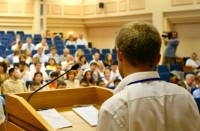By James Dacey

Whether you love giving them or loathe the entire experience, everyone has to deliver a presentation at some point during an academic career – be they student or professional researcher. It might be the presentation of your results to supervisors and peers. Or it might be an outreach talk to explain your research to people who have probably never heard of you or your very interesting academic niche. There is no magic formula to giving a successful presentation, but instinctively I think we all know when it’s gone well. Likewise, I think we all know when we could have spent a bit more time whipping those slides into shape, or when we perhaps should have put a bit more thought into the appropriateness of that risqué joke.
In an interesting article that appeared in the March issue of Physics World, writer and broadcaster Sharon Ann Holgate examines how lessons from sports psychology can help academics win over their audiences when it matters. She writes about the need to “build up” to the event of giving a talk, in the same way that an athlete would prepare for a competition. Holgate writes about the need to make manageable changes to a talk, and of practicing in front of relatives and peers. She also emphasizes the importance of imagining the delivery of a successful talk. She lays out a framework called PETTLEP, developed by the sports psychologist David Smith. PETTLEP includes elements such as imagining your physical sensations as you give the talk, the environment in which you are giving the talk, the tasks required, etc. You can read the full article here.
In this week’s Facebook poll, we want you to respond to the following question:
What is the most common problem with academic presentations?
Too long
Dodgy slides
Pitched at the wrong level
Failure to engage the audience
Use of Comic Sans typeface
Please cast your vote by visiting our Facebook page. If you want to select something else as a choice, please can you post a comment on the poll to let us know what you have in mind.
In last week’s poll we asked you whether you think more leading scientists should engage in public service. The question was inspired by a new docudrama aired on UK television last week about the role Richard Feynman played in the investigation into the causes of the Challenger disaster. Depicting the events of the real investigation, Feynman’s analytical approach helps the inquiry get to the bottom of the technical and bureaucratic errors in this dark chapter in NASA’s history.
Perhaps enthused by Feynman’s brilliance, 93% of respondents voted that “yes”, more leading should get involved with public service. While the remaining 7% believe that “no” they should not.
The poll also led to an interesting discussion on our Facebook page. For instance, one follower, Antoine de Saint-Exupéry, wrote “I admire those that have the skills and motivation to do so and they should certainly be supported. I do not, however, feel that there is necessarily a need for more leading scientists to do so.” Meanwhile, another participant, Jonathan Shimwell, was more cautious. “I really like engagement, but when it is done badly, it can have negative effects. Pressuring people to do outreach, particularly those who don’t want to be included, probably increases the likelihood of bad outreach,” he wrote.
Thanks for all your participation and we hope to hear from you again this week.
Trackback: What is the most common problem with academic presentations? | Diary of F511 (Year 0)
A teacher with a good sense of pedagogy who can inculcate something concrete in a class of 100 students, should be good everywhere and there is no need to torture a mirror.
In my view ANIMATION-BASED web-oriented teaching is BEST COMMUNICATION strategy for Young-budding students to have grasp over PHYSICS
Trackback: Blog - physicsworld.com